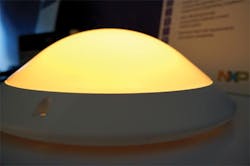Our annual One Bright Issue covers the latest in LED and display technologies. For my part, I thought I would write about a couple of LED products that I saw at Electronica late last year and International CES earlier this year.
What Color Is Your LED Lamp?
At Electronica, I had a long talk with Radu Surdeanu, principal scientist at NXP Semiconductors. He explained that many people are dissatisfied with the light that’s emitted by LED bulbs and lamps, at least compared to the good old incandescent light bulb. This is especially true when dimming the LED bulb.
With incandescent bulbs, light becomes “warmer” as the bulb is dimmed. This essentially means the color of the light changes as the incandescent bulb dims. Since this isn’t the case with LED bulbs, NXP researchers set out to mimic those color changes. The idea is to give consumers the same lighting experience they are used to with incandescents.
The solution NXP developed is based on “sensorless sensing” technology. As you dim an LED lamp with this technology, the light appears warmer and cozier (see the figure). Developed and patented by NXP, the solution not only affects the light, it also drives down LED system costs by eliminating external temperature sensors, reducing the size of the heatsinks required for LED system cooling and significantly improving reliability.
Surdeanu explained how NXP makes an LED mimic an incandescent when dimming. First, the company combines white and amber LEDs to create colors that are most pleasing to the human eye, following the black-body radiation curve. Then it implements a logarithmic correction for eye sensitivity that entails an analytical model for achieving the desired color points while dimming. Finally, it uses the sensorless sensing technology to measure LED junction temperature directly, which provides accurate, efficient real-time temperature correction—a must for reliable control of LED performance under any conditions.
I asked a representative from NXP if this technology would remain in lamp form or be incorporated into a bulb, but she said the company has not released any products using it yet. If you want to find out more, NXP’s R&D team has produced a video available on YouTube.
A New Bulb From Rambus?
Known for its prowess in memory technology, Rambus has developed a new LED bulb—well, not exactly. But Rambus did buy a company that had developed a new LED bulb technology. When I walked by the Rambus booth in January at Pepcom’s Digital Experience, a small trade show the evening before the exhibits open at CES, I stopped dead in my tracks and tried to digest the news.
Related Articles
• Wind Turbines Play In Paradise, But Not In Falmouth (.PDF)
• New Ways To Charge Up Your Mobile Devices
• CES Proves That 4G LTE Still Has A Long Way To Go
John Thomas, a vice president at Rambus, explained how the LED bulb works. Instead of providing direct lighting, the LEDs shine on a light guide that provides the illumination.
The cylindrical, edge-lit light guide—the bulb uses three of them—is patterned with MicroLens optics to deliver the maximum amount of light from the LEDs. Using this technique, the Rambus light bulb provides an efficient, controlled light distribution without the need for additional diffusers that can reduce efficiency. By varying the size, shape, density, and location of the MicroLens optics in the light guide, the bulb delivers an even, spherical, and high-quality light distribution, just like a traditional incandescent. You can view a video of the Rambus bulb on Engineering TV.
This technology is not just for bulbs, though. Thomas showed me a modern lamp that used the same technology, sans bulb.
At home, we’ve switched out most of our incandescents for compact fluorescents, not LED bulbs. My chief complaint with fluorescents is the warm-up period until they achieve full brightness, not with the color. LED bulbs will certainly solve this problem, and I’m sure I’ll be trying some soon.

